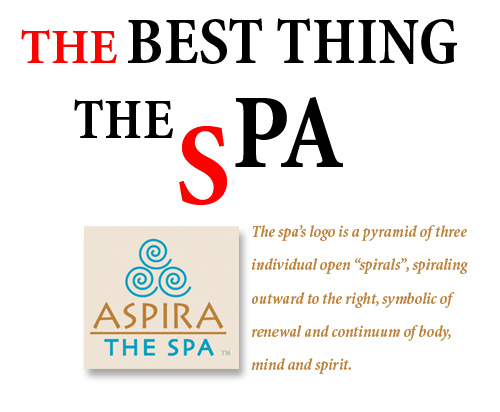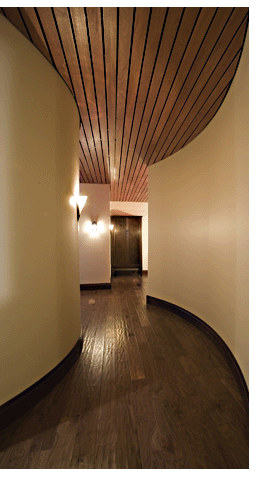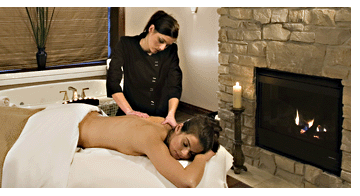|

 Aspira Spa’s (“infused with spirit”) Aspira Spa’s (“infused with spirit”)
design is sensory-driven
symbolism. Its menu of services
offers treatments that are
traditional and non-traditional,
with many being exclusive to the
Midwest. The spa’s logo is a
pyramid of three individual open
“spirals”, spiraling outward to the
right, symbolic of renewal and
continuum of body, mind and
spirit. The spa’s design concept
and treatments are based on the
five elements of Chinese
philosophy. The individual
elements also have corollary
colors (wood/green or blue,
fire/red, earth/yellow,
metal/white, and water/black),
and other characteristics such as
seasons, substance, direction,
motion, emotions, etc. All relate
to each other and are
interconnected.
Aspira Spa’s architectural design,
incorporating these elements, is visually stimulating and impressive. The spa’s main areas are a convergence of three individual circles, where the body, mind and spirit can meditate, experience water and the fire’s warmth, or “feed” the mind with reflective resource material. Throughout the spa, organic substances include indigenous stone, mahogany and walnut wood, (artisan-planed, reminiscent of gentle waves of water), copper water vessel (reflective light and warmth), fireplaces and soy candles (emanating light and warmth). The organic substances reinforce the connectivity of these five elements, including the body, mind and spirit, and aspects of Chinese Feng Shui (air, water, balance, harmony). On the treatment side, the spa further correlates these elements by associating a treatment efficacy to a specific element. The following table reflects this correlation.
Element Color Season Aspira Spa Effect
Wood Green or Blue Spring Energizing
Fire Red Summer Cooling
Earth Yellow Transition/Between Releasing/Detoxifying
Metal White Autumn Relaxing
Water Black Winter Toning
The spa’s holistic approach to healing includes treatments that are based on global therapies, indigenous to Asia, the Pacific, North America, the Middle East, and Europe. Aspira Spa’s extensive and unique treatment offerings are all geared towards aspects of the five Chinese elements, and include massage therapy, balneotherapy, chromatherapy, reflexology, body treatments (referred to as “dynamic envelopments”), facials, therapeutic rituals (referred to as “Aspira Spa Complements”), and salon services.
Another unique aspect to the spa is that it offers its guests the option to take their treatments in the privacy of individual spa suites, which are separate from the spa's individual treatment rooms. Each spa suite includes a private whirlpool, fireplace and treatment area; however, the larger spa suites also include private lavatories, shower facilities, and sofas; these large rooms also accommodate tandem treatment options. Guests reserving the larger spa suites also receive a choice of beverages, nuts and fresh fruit served to them post-treatment, or they can order spa cuisine from the Café and have it served to them in the spa suite. The suites can be reserved for up to f our-hours, and can accommodate up to four people. The suites are ideal for couples, groups of friends, or wedding parties. our-hours, and can accommodate up to four people. The suites are ideal for couples, groups of friends, or wedding parties.
The spa’s exclusive treatment line is by Phytobiodermie (www.phytobiodermie.com). This Swiss company’s products incorporate organic and natural ingredients that synergistically conform to the color principles of the five elements to restore, rebalance and rejuvenate. Phytobiodermie was the first company to esthetically incorporate these five elements, using light therapy (chromatherapy) and lymphatic drainage.
My treatments at the spa included the Lomi-Lomi massage, foot reflexology and the Chromalift facial. Although I’ve read about the Lomi-Lomi massage and heard others describe how they felt after getting one of these massages, I had never experienced this unique massage therapy, until I found myself at the Aspira Spa. So, I decided to be adventuresome and bear it all. My therapist was exceptional, her technique incredible, and her explanations about the individual techniques was very informative.
Although I’ve had foot reflexology before, I was also impressed with the skill level of my therapist; however, the use of different colored essential oils on the various segments didn’t seem to impact the treatment’s efficacy. The Chromalift facial was a rather unusual treatment experience, and one I hadn’t experienced before my visit to the spa. Overall, the treatment aspects rendered a noticeable, albeit marginal, visible result (a slight improvement (lifting affect) to the definition along my lower jowl area). Phytobiodermie recommends a consecutive series of between three to five treatments for optimum results (each one focusing on additional color therapy, mask and “acupuncture” techniques; the latter according to the product’s website); the company “guarantees” visible results with just one treatment.
T he treatment utilizes several of Phytobiodermie’s proprietary pieces of equipment; the “Biodraineur”, which gives a pulsating (and suction) massage, which stimulates draining the lymphatic system of toxins; the “Chromapuncteur”, which emits variable colored light (vibration); the “Biostimulateur”, which vibrates and is concentrated on “acupuncture” and reflex areas for energy flow. The products used were gentle and non-irritating, with a pleasant aroma. The only aspect of “irritation” for me was when my esthetician positioned the suction elements over both of my eardrums, at the same time. The pulling and suction over such a sensitive area as an eardrum opening, was rather painful; my esthetician did stop once I told her to do so (not being an esthetician, this shouldn’t be part of the treatment protocol, and should be eliminated and avoided; although the eardrum is an acupuncture region, using suction over such a sensitive area is invasive, painful, non-essential, and can potentially lead to injury). .. he treatment utilizes several of Phytobiodermie’s proprietary pieces of equipment; the “Biodraineur”, which gives a pulsating (and suction) massage, which stimulates draining the lymphatic system of toxins; the “Chromapuncteur”, which emits variable colored light (vibration); the “Biostimulateur”, which vibrates and is concentrated on “acupuncture” and reflex areas for energy flow. The products used were gentle and non-irritating, with a pleasant aroma. The only aspect of “irritation” for me was when my esthetician positioned the suction elements over both of my eardrums, at the same time. The pulling and suction over such a sensitive area as an eardrum opening, was rather painful; my esthetician did stop once I told her to do so (not being an esthetician, this shouldn’t be part of the treatment protocol, and should be eliminated and avoided; although the eardrum is an acupuncture region, using suction over such a sensitive area is invasive, painful, non-essential, and can potentially lead to injury). ..
© SPA MANAGEMENT JOURNAL - APRIL 2006
|
|
|